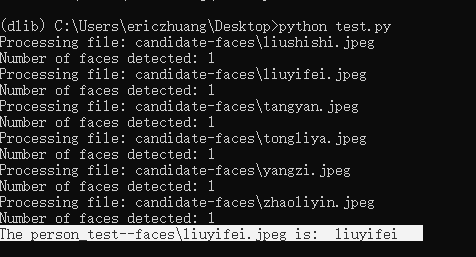人脸识别《二、 基于Dlib库实现人脸检测、特征点检测、人脸对齐、人脸识别》
首先需要安装dlib库以及opencv,上一节已经说明如何安装dlib,这边需要再安装一下opencv
pip install numpy
由于我安装的python版本是3.6,直接使用pip install opencv-python安装会报错。
pip install -i https://pypi.douban.com/simple/ pip install opencv-python==4.3.0.38
以下demo是基于shape_predictor_68_face_landmarks.dat的模型进行推理的。该模型在上一节有下载地址。
1.人脸检测
# encoding:utf-8 import dlib import numpy as np import cv2 def rect_to_bb(rect): # 获得人脸矩形的坐标信息 x = rect.left() y = rect.top() w = rect.right() - x h = rect.bottom() - y return (x, y, w, h) def resize(image, width=1200): # 将待检测的image进行resize r = width * 1.0 / image.shape[1] dim = (width, int(image.shape[0] * r)) resized = cv2.resize(image, dim, interpolation=cv2.INTER_AREA) return resized def detect(): image_file = "test.jpg" detector = dlib.get_frontal_face_detector() image = cv2.imread(image_file) image = resize(image, width=1200) gray = cv2.cvtColor(image, cv2.COLOR_BGR2GRAY) rects = detector(gray, 1) for (i, rect) in enumerate(rects): (x, y, w, h) = rect_to_bb(rect) cv2.rectangle(image, (x, y), (x + w, y + h), (0, 255, 0), 2) cv2.putText(image, "Face: {}".format(i + 1), (x - 10, y - 10), cv2.FONT_HERSHEY_SIMPLEX, 0.5, (0, 255, 0), 2) cv2.imshow("Output", image) cv2.waitKey(0) if __name__ == "__main__": detect()
结果:

2.特征点检测
# encoding:utf-8 import dlib import numpy as np import cv2 def rect_to_bb(rect): # 获得人脸矩形的坐标信息 x = rect.left() y = rect.top() w = rect.right() - x h = rect.bottom() - y return (x, y, w, h) def shape_to_np(shape, dtype="int"): # 将包含68个特征的的shape转换为numpy array格式 coords = np.zeros((68, 2), dtype=dtype) for i in range(0, 68): coords[i] = (shape.part(i).x, shape.part(i).y) return coords def resize(image, width=1200): # 将待检测的image进行resize r = width * 1.0 / image.shape[1] dim = (width, int(image.shape[0] * r)) resized = cv2.resize(image, dim, interpolation=cv2.INTER_AREA) return resized def feature(): image_file = "test.jpg" detector = dlib.get_frontal_face_detector() predictor = dlib.shape_predictor("shape_predictor_68_face_landmarks.dat") image = cv2.imread(image_file) image = resize(image, width=1200) gray = cv2.cvtColor(image, cv2.COLOR_BGR2GRAY) rects = detector(gray, 1) shapes = [] for (i, rect) in enumerate(rects): shape = predictor(gray, rect) shape = shape_to_np(shape) shapes.append(shape) (x, y, w, h) = rect_to_bb(rect) cv2.rectangle(image, (x, y), (x + w, y + h), (0, 255, 0), 2) cv2.putText(image, "Face: {}".format(i + 1), (x - 10, y - 10), cv2.FONT_HERSHEY_SIMPLEX, 0.5, (0, 255, 0), 2) for shape in shapes: for (x, y) in shape: cv2.circle(image, (x, y), 2, (0, 0, 255), -1) cv2.imshow("Output", image) cv2.waitKey(0) if __name__ == "__main__": feature()
结果:

3. 人脸对齐
执行:
pip install matplotlib
代码:
# encoding:utf-8 import dlib import cv2 import matplotlib.pyplot as plt import numpy as np import math def rect_to_bb(rect): # 获得人脸矩形的坐标信息 x = rect.left() y = rect.top() w = rect.right() - x h = rect.bottom() - y return (x, y, w, h) def face_alignment(faces): predictor = dlib.shape_predictor("shape_predictor_68_face_landmarks.dat") # 用来预测关键点 faces_aligned = [] for face in faces: rec = dlib.rectangle(0,0,face.shape[0],face.shape[1]) shape = predictor(np.uint8(face),rec) # 注意输入的必须是uint8类型 order = [36,45,30,48,54] # left eye, right eye, nose, left mouth, right mouth 注意关键点的顺序,这个在网上可以找 for j in order: x = shape.part(j).x y = shape.part(j).y cv2.circle(face, (x, y), 2, (0, 0, 255), -1) eye_center =((shape.part(36).x + shape.part(45).x) * 1./2, # 计算两眼的中心坐标 (shape.part(36).y + shape.part(45).y) * 1./2) dx = (shape.part(45).x - shape.part(36).x) # note: right - right dy = (shape.part(45).y - shape.part(36).y) angle = math.atan2(dy,dx) * 180. / math.pi # 计算角度 RotateMatrix = cv2.getRotationMatrix2D(eye_center, angle, scale=1) # 计算仿射矩阵 RotImg = cv2.warpAffine(face, RotateMatrix, (face.shape[0], face.shape[1])) # 进行放射变换,即旋转 faces_aligned.append(RotImg) return faces_aligned def demo(): im_raw = cv2.imread('test.jpg').astype('uint8') detector = dlib.get_frontal_face_detector() gray = cv2.cvtColor(im_raw, cv2.COLOR_BGR2GRAY) rects = detector(gray, 1) src_faces = [] for (i, rect) in enumerate(rects): (x, y, w, h) = rect_to_bb(rect) detect_face = im_raw[y:y+h,x:x+w] src_faces.append(detect_face) cv2.rectangle(im_raw, (x, y), (x + w, y + h), (0, 255, 0), 2) cv2.putText(im_raw, "Face: {}".format(i + 1), (x - 10, y - 10), cv2.FONT_HERSHEY_SIMPLEX, 0.5, (0, 255, 0), 2) faces_aligned = face_alignment(src_faces) cv2.imshow("src", im_raw) i = 0 for face in faces_aligned: cv2.imshow("det_{}".format(i), face) i = i + 1 cv2.waitKey(0) if __name__ == "__main__": demo()
结果:

4. 人脸识别
问题:
ModuleNotFoundError: No module named 'skimage'
解决:
pip install scikit-image
代码:
# encoding:utf-8 import dlib import cv2 import matplotlib.pyplot as plt import numpy as np import math import os, glob from skimage import io def create_face_space(): # 对文件夹下的每一个人脸进行: # 1.人脸检测 # 2.关键点检测 # 3.描述子提取 # 候选人脸文件夹 faces_folder_path = "candidate-faces/" # 候选人脸描述子list descriptors = [] for f in glob.glob(os.path.join(faces_folder_path, "*.jpeg")): print("Processing file: {}".format(f)) img = io.imread(f) # 1.人脸检测 dets = detector(img, 1) print("Number of faces detected: {}".format(len(dets))) for k, d in enumerate(dets): # 2.关键点检测 shape = sp(img, d) # 3.描述子提取,128D向量 face_descriptor = facerec.compute_face_descriptor(img, shape) # 转换为numpy array v = np.array(face_descriptor) descriptors.append(v) return descriptors def predict(descriptors,path): # 对需识别人脸进行同样处理 # 提取描述子 img = io.imread(path) dets = detector(img, 1) dist = [] for k, d in enumerate(dets): shape = sp(img, d) face_descriptor = facerec.compute_face_descriptor(img, shape) d_test = np.array(face_descriptor) # 计算欧式距离 for i in descriptors: dist_ = np.linalg.norm(i-d_test) dist.append(dist_) return dist def demo(): global detector, sp, facerec # 加载正脸检测器 detector = dlib.get_frontal_face_detector() # 加载人脸关键点检测器 sp = dlib.shape_predictor("shape_predictor_68_face_landmarks.dat") # 3. 加载人脸识别模型 facerec = dlib.face_recognition_model_v1("dlib_face_recognition_resnet_model_v1.dat") descriptors = create_face_space() # 候选人名单 candidate = ['zhaoliying', 'liuyifei', 'liushishi', 'tangyan', 'tongliya', 'yangzi'] predict_path = "test--faces/" for f in glob.glob(os.path.join(predict_path, "*.jpeg")): dist = predict(descriptors, f) # 候选人和距离组成一个dict c_d = dict(zip(candidate, dist)) cd_sorted = sorted(c_d.items(), key=lambda d:d[1]) print ("The person_{} is: ".format(f),cd_sorted[0][0]) if __name__ == "__main__": demo()
在candidate-faces/文件夹中放6个明星的照片,格式要转换成jpg,不能直接改后缀名,不然会报错。
在test--faces/放入待检测的图片

分类:
目标检测 - 人脸识别





【推荐】国内首个AI IDE,深度理解中文开发场景,立即下载体验Trae
【推荐】编程新体验,更懂你的AI,立即体验豆包MarsCode编程助手
【推荐】抖音旗下AI助手豆包,你的智能百科全书,全免费不限次数
【推荐】轻量又高性能的 SSH 工具 IShell:AI 加持,快人一步
· 被坑几百块钱后,我竟然真的恢复了删除的微信聊天记录!
· 【自荐】一款简洁、开源的在线白板工具 Drawnix
· 没有Manus邀请码?试试免邀请码的MGX或者开源的OpenManus吧
· 园子的第一款AI主题卫衣上架——"HELLO! HOW CAN I ASSIST YOU TODAY
· 无需6万激活码!GitHub神秘组织3小时极速复刻Manus,手把手教你使用OpenManus搭建本
2022-04-27 《设备树》